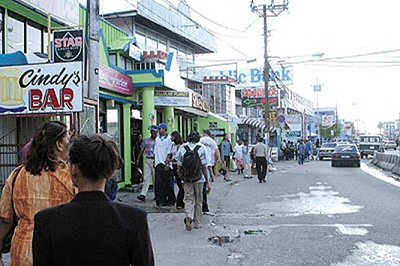| Chaguanas – Part II - Bursting at the
seams
Published
Thursday 12th August, 2004

Photo: DAVID WEARS
This week we continue our examination of Chaguanas, the ‘new
Capital of Trinidad’.
This article will outline some of the main challenges arising from
the rapid pace of development there. In the early period of UNC
governance, Lloyd Best made the declaration that the ‘pendulum had
swung from the Port to the Plantation’. Best’s statement provoked
much controversy, despite the underlying rationale in our political
economy. Today, we can mention anecdotal evidence that, for at least 2
of our major banks, Chaguanas provides the most profitable branches,
comfortably outstripping the results of the traditional commercial
centres at POS and San Fernando. One would not be surprised to learn
that this was the case for all the commercial banks.
In our view, the key difference between development here and in other
parts of the country is that most of the private building is
self-financed with limited bank financing needed to start. Given that it
is not strictly necessary to seek statutory consent if you are not
seeking bank financing and our national practice of avoiding
regulations, there is a great incidence of unauthorised structures with
implications for Chaguanas’ future development.
The key issues emerging in the medium term for Chaguanas would
include –
-
Town Planning – The plan being used by the Town & Country
Planning Division for this rapidly-growing part of the country is
outdated and sorely in need of revision. The UDECOTT document quoted
in last week’s article forms the background study to the required
new plan but the existing frame of reference continues to pose a
challenge until that revision takes place. The State cannot plan,
far less provide, proper infrastructure without quality information
on present demand as well as the likely nature and level of future
requirements. That is the rationale behind the regulatory framework.
-
Infrastructure Deficit - The rate and quality of private
development in Chaguanas has been such that the infrastructure
facilities lag well behind what one would expect at this point. For
example - Most of the surface water is still carried by open earthen
drains. TSTT has a perennial shortage of new lines. The Borough is
not connected to WASA’s sewerage system and therefore relies on
privately-built treatment plants or soakaways. Given this
infrastructure deficit and the pattern of unauthorised development
in one of the country’s fastest-growing districts, it is a great
challenge to move forward without disrupting the success of the
private sector there. For the Borough to realise its potential, it
would be necessary for the State to make significant infrastructural
investment to provide for that growth.
-
New Commercial developments in Chaguanas – In tandem with
POS, there is a new pattern of development in that the new
commercial users are choosing to locate out of the traditional
centre of the town. Recently we saw offered for sale of over 9 acres
set out in 8 parcels of land at the Mulchan Seuchan Road, on the
eastern edge of the towncentre. This is the preferred location for
the class of users under discussion and we can expect to see new
records being set for land prices in the series of sales, together
with some further migrations out of the towncentre.
-
The release of the Caroni Lands – The unknown factor in
all this is the role of the extensive Caroni lands on the pattern of
land values and development of the Borough. A significant part of
the area surrounding Chaguanas is owned by Caroni and the planned
release of these can open up new possibilities for the sustainable
development of the area. We return to the concerns raised in our
earlier series on Caroni lands and the continuing uncertainty as to
the proposals for this resource. Risk is a real part of the business
environment, but continuing uncertainty on a question of this
magnitude is adding to the challenges of taking the Borough to next
level of its development.
The organic and unplanned development of Chaguanas belies its great
potential as an exemplar for the nation. The Borough is not yet caught
in the depth of problems that beset our other cities so we therefore
have an opportunity to develop a city to the very best level we can. The
presence and proximity of the undeveloped Caroni lands, the immature
state of the infrastructure, the thriving commerce in the area and the
relative wealth of the period all signal a new set of possibilities for
Chaguanas. This is a challenge to establish a new precedent as to the
best new Caribbean city. Do we have the vision and endurance to set a
new standard for our children and ourselves?
Next week, we begin to look at the City of San Fernando and its real
estate picture.
| NEW RESIDENTIAL DEVELOPMENTS IN CHAGUANAS
Some of the new developments planned in this area include –
- ‘Savitur’, Freeport. This is the Hindu Credit Union’s
new, gated community, reportedly sold-out at record prices for that
area.
- ‘Aberdeen Park’, Edinburgh. This is Caribbean Housing’s
new development, also at record prices and with strong sales.
- ‘Ozone Park’, Chase Village. This is a gated development
of factory-built homes by the Amar Group; these are also being sold
at record prices for that area
- ‘Cashew Gardens’, Carlsen Field. This is an NHA
development with more modestly-priced units
|
|

|
The organic and
unplanned development of Chaguanas belies its great potential as
an exemplar for the nation. The Borough is not yet caught in the
depth of problems that beset our other cities so we therefore
have an opportunity to develop a city to the very best level we
can. |
|

